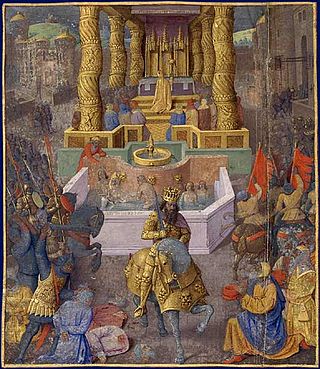
The 30s decade ran from January 1, AD 30, to December 31, AD 39.
This article concerns the period 39 BC – 30 BC.
Herod I or Herod the Great was a Roman Jewish client king of the Herodian kingdom of Judea. He is known for his colossal building projects throughout Judea. Among these works are the rebuilding of the Second Temple in Jerusalem and the expansion of its base—the Western Wall being part of it. Vital details of his life are recorded in the works of the 1st century CE Roman–Jewish historian Josephus.
Abilene or simply Abila was a plain, a district in Coele-Syria, of which the chief town was Abila Lysaniou. The limits of this region are nowhere exactly defined, but it seems to have included the eastern slopes of the Anti-Lebanon range, and to have extended south and southeast of Damascus as far as the borders of Galilaea, Batanaea, and Trachonitis. According to Flavius Josephus, Abilene was a separate Iturean kingdom until 37 AD.

Herod Agrippa, also known as Agrippa I or Agrippa the Great, was the last king of Judea. He was a grandson of Herod the Great and the father of Herod Agrippa II, the last known king from the Herodian dynasty. He was an acquaintance or friend of Roman emperors and played crucial roles in internal Roman politics.

Herod Agrippa II, officially named Marcus Julius Agrippa and sometimes shortened to Agrippa, was the last ruler from the Herodian dynasty, reigning over territories outside of Judea as a Roman client. Agrippa II fled Jerusalem in 66, fearing the Jewish uprising, and he supported the Roman side in the First Jewish–Roman War.

The Hasmonean dynasty was a ruling dynasty of Judea and surrounding regions during the Hellenistic times of the Second Temple period, from c. 140 BCE to 37 BCE. Between c. 140 and c. 116 BCE the dynasty ruled Judea semi-autonomously within the Seleucid Empire, and from roughly 110 BCE, with the empire disintegrating, gained further autonomy and expanded into the neighboring regions of Perea, Samaria, Idumea, Galilee, and Iturea. The Hasmonean rulers took the Greek title basileus ("king") and the kingdom attained regional power status for several decades. Forces of the Roman Republic intervened in the Hasmonean Civil War in 63 BCE, turning the kingdom into a client state and marking an irreversible decline of Hasmonean power; Herod the Great displaced the last reigning Hasmonean client-ruler in 37 BCE.

Herod Antipas was a 1st-century ruler of Galilee and Perea. He bore the title of tetrarch and is referred to as both "Herod the Tetrarch" and "King Herod" in the New Testament. He was a son of Herod the Great and a grandson of Antipater the Idumaean. He is widely known today for accounts in the New Testament of his role in events that led to the executions of John the Baptist and Jesus of Nazareth. His father, Herod the Great, was described in the account as ordering the Massacre of the Innocents, marking the earliest Biblical account of the concerns of the government in Jerusalem regarding Jesus' existence.

Judaea was a Roman province from 6 to 132 CE, which at its height incorporated the Levantine regions of Judea, Idumea, Samaria, and Galilee, and parts of the costal plain including Philistia, extending over the territories of the Hasmonean and Herodian kingdoms. The name Judaea was derived from the Iron Age Kingdom of Judah, that was centered predominantly in Judea.
Ptolemy or Ptolemaeus, son of Mennaeus (Mennæus) was tetrarch of Iturea and Chalcis from about 85 BC to 40 BC, in which year he died. He tried to extend his kingdom by warlike expeditions ; and ruled the Lebanon, threatened Damascus, subjugated several districts on the Phoenician coast, and once had Paneas in his hands. In fact, the whole of Galilee had formerly been in the possession of the Itureans, and had been taken away from them in 103 BC by Aristobulus I..

Aristobulus V of Chalcis was a son of Herod of Chalcis and his first wife Mariamne. Herod of Chalcis, ruler of Chalcis in Iturea, was a grandson of Herod the Great through his father, Aristobulus IV. Mariamne was a granddaughter of Herod the Great through her mother, Olympias; hence Aristobulus was a great-grandson of Herod the Great on both sides of his family.

The Herodian dynasty was a royal dynasty of Idumaean (Edomite) descent, ruling the Herodian Kingdom of Judea and later the Herodian tetrarchy as a vassal state of the Roman Empire. The Herodian dynasty began with Herod the Great who assumed the throne of Judea, with Roman support, bringing down the century-old Hasmonean Kingdom. His kingdom lasted until his death in 4 BCE, when it was divided among his sons and daughter as a tetrarchy, which lasted for about 10 years. Most of those tetrarchies, including Judea proper, were incorporated into Judaea Province from 6 CE, though limited Herodian de facto kingship continued until Agrippa I's death in 44 CE and nominal title of kingship continued until c. 92 or 100 CE, when the last Herodian monarch, king Agrippa II, died and Rome assumed full power over his de jure domain.
Phasael, was a prince from the Herodian Dynasty of Judea.

The Herodian tetrarchy was a regional division of a client state of Rome, formed following the death of Herod the Great in 4 BCE. The latter's client kingdom was divided between his sister Salome I and his sons Herod Archelaus, Herod Antipas, and Philip. Upon the deposition of Herod Archelaus in 6 CE, his territories were transformed into a Roman province. With the death of Salome I in 10 CE, her domain was also incorporated into a province.

Philip the Tetrarch, sometimes called Herod Philip II by modern writers was the son of Herod the Great and his fifth wife, Cleopatra of Jerusalem. As a Tetrarch, he ruled over the northeast part of his father's kingdom between 4 BCE and 34 CE after Herod's death. He was a half-brother of Herod Antipas and Herod Archelaus. He is not the same person as Herod II, whom some writers call Herod Philip I.
Zenodorus was the ruler of a small principality in the vicinity of Damascus described by Josephus as the "house of Lysanias", 23-20 BCE.

The Herodian kingdom was a client state of the Roman Republic ruled from 37 to 4 BCE by Herod the Great, who was appointed "King of the Jews" by the Roman Senate. When Herod died, the kingdom was divided among his sons into the Herodian Tetrarchy.

Herod the Great's siege of Jerusalem was the final step in his campaign to secure the throne of Judea. Aided by Roman forces provided by Marcus Antonius, Herod was able to capture the city and depose Antigonus II Mattathias, ending Hasmonean rule. The siege appears in the writings of Josephus and Dio Cassius.

This article lists historical events that occurred between 1–100 in modern-day Lebanon or regarding its people.













